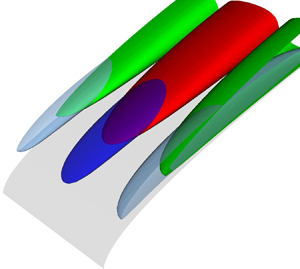Crossref Citations
This article has been cited by the following publications. This list is generated based on data provided by
Crossref.
Kaplan, Oğuzhan
Jordan, Peter
Cavalieri, André V.G.
and
Brès, Guillaume A.
2021.
Nozzle dynamics and wavepackets in turbulent jets.
Journal of Fluid Mechanics,
Vol. 923,
Issue. ,
Rodriguez, Daniel
Martini, Eduardo
Cavalieri, Andrè
and
Jordan, Peter
2021.
On the relation between the self-excited three-dimensionality of laminar separation bubbles and their receptivity to external disturbances.
Chen, Zhibo
and
Towne, Aaron
2021.
An azimuthal Fourier domain formulation of the Ffowcs Williams and Hawkings equation.
The Journal of the Acoustical Society of America,
Vol. 150,
Issue. 3,
p.
1967.
Farghadan, Ali
Towne, Aaron
Martini, Eduardo
and
Cavalieri, Andrè
2021.
A randomized time-domain algorithm for efficiently computing resolvent modes.
Tissot, Gilles
Cavalieri, André V. G.
and
Mémin, Étienne
2021.
Stochastic linear modes in a turbulent channel flow.
Journal of Fluid Mechanics,
Vol. 912,
Issue. ,
Herrmann, Benjamin
Baddoo, Peter J.
Semaan, Richard
Brunton, Steven L.
and
McKeon, Beverley J.
2021.
Data-driven resolvent analysis.
Journal of Fluid Mechanics,
Vol. 918,
Issue. ,
Towne, Aaron
Rigas, Georgios
Kamal, Omar
Pickering, Ethan
and
Colonius, Tim
2022.
Efficient global resolvent analysis via the one-way Navier–Stokes equations.
Journal of Fluid Mechanics,
Vol. 948,
Issue. ,
Sasaki, Kenzo
Cavalieri, André V. G.
Hanifi, Ardeshir
and
Henningson, Dan S.
2022.
Parabolic resolvent modes for streaky structures in transitional and turbulent boundary layers.
Physical Review Fluids,
Vol. 7,
Issue. 10,
Blanco, Diego C.P.
Martini, Eduardo
Sasaki, Kenzo
and
Cavalieri, André V.G.
2022.
Improved convergence of the spectral proper orthogonal decomposition through time shifting.
Journal of Fluid Mechanics,
Vol. 950,
Issue. ,
Barthel, Benedikt
Gomez, Salvador
and
McKeon, Beverley J.
2022.
Variational formulation of resolvent analysis.
Physical Review Fluids,
Vol. 7,
Issue. 1,
Martini, Eduardo
Jung, Junoh
Cavalieri, André V.G.
Jordan, Peter
and
Towne, Aaron
2022.
Resolvent-based tools for optimal estimation and control via the Wiener–Hopf formalism.
Journal of Fluid Mechanics,
Vol. 937,
Issue. ,
Arun, Rahul
Bae, H. Jane
and
McKeon, Beverley J.
2023.
Towards real-time reconstruction of velocity fluctuations in turbulent channel flow.
Physical Review Fluids,
Vol. 8,
Issue. 6,
Hou, Wei
and
Colonius, Tim
2023.
Three-dimensional Stability and Resolvent Analysis of External Flows Over Spanwise-homogeneous Immersed Bodies.
Poulain, Arthur
Content, Cédric
Sipp, Denis
Rigas, Georgios
and
Garnier, Eric
2023.
BROADCAST: A high-order compressible CFD toolbox for stability and sensitivity using Algorithmic Differentiation.
Computer Physics Communications,
Vol. 283,
Issue. ,
p.
108557.
Tissot, Gilles
Cavalieri, André V. G.
and
Mémin, Étienne
2023.
Input-output analysis of the stochastic Navier-Stokes equations: Application to turbulent channel flow.
Physical Review Fluids,
Vol. 8,
Issue. 3,
Ribeiro, J.H. Marques
Yeh, Chi-An
and
Taira, Kunihiko
2023.
Triglobal resolvent analysis of swept-wing wakes.
Journal of Fluid Mechanics,
Vol. 954,
Issue. ,
Guo, Peixu
Hao, Jiaao
and
Wen, Chih-Yung
2023.
Interaction and breakdown induced by multiple optimal disturbances in hypersonic boundary layer.
Journal of Fluid Mechanics,
Vol. 974,
Issue. ,
Zhu, Min
and
Towne, Aaron
2023.
Recursive one-way Navier-Stokes equations with PSE-like cost.
Journal of Computational Physics,
Vol. 473,
Issue. ,
p.
111744.
Ballouz, Eric
Lopez-Doriga, Barbara
Dawson, Scott T.M.
and
Bae, H. Jane
2024.
Wavelet-based resolvent analysis of non-stationary flows.
Journal of Fluid Mechanics,
Vol. 999,
Issue. ,
Farghadan, Ali
Jung, Junoh
Bhagwat, Rutvij
and
Towne, Aaron
2024.
Efficient harmonic resolvent analysis via time stepping.
Theoretical and Computational Fluid Dynamics,
Vol. 38,
Issue. 3,
p.
331.



